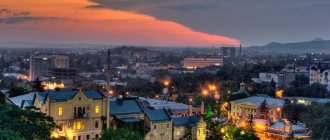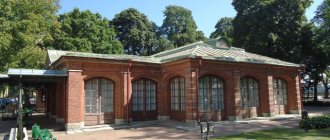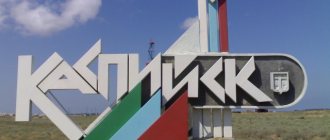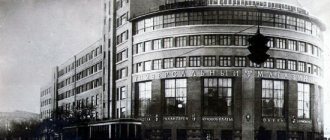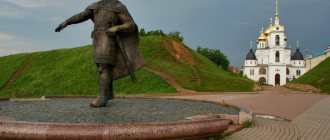Toropets: areas, recreation, excursions, museums and churches, cuisine and restaurants, shopping and shops, attractions of Toropets.
- May tours
to Russia - Last minute tours
to Russia
Toropets is an ancient county town located on the shores of the beautiful Lake Solomeno. Tourists come here, as a rule, for one or two days to enjoy the silence and measured pace of life in the city and get acquainted with the charming architecture of Toropets.
Today, alas, few people know that it was in Toropets that Alexander Nevsky got married and Patriarch Tikhon spent his childhood.
Story
First mention
Toropets was first mentioned in chronicles in 1074. The chronicle text speaks of the death in the Kiev-Pechersk monastery of a Toropchanian, the Monk Isaac of Pechersk ( a Toropchanian merchant named Chern)
.
The city itself was first mentioned in documents in 1168 as the center of the independent Toropets principality (the ancient ramparts preserved in the city center, probably built by the Toropets prince Mstislav Rostislavich the Brave, the son of the Smolensk prince Rostislav, date back to the 12th century).
Middle Ages
The Toropets principality was small and was located in the upper reaches of the Toropa and Zapadaya Dvina rivers, bordering the lands of Smolensk, Novgorod and Polotsk. The famous route from the Varangians to the Greeks passed through the city. After the death of Mstislav Rostislavich, the reign passed to his son Mstislav Mstislavich, later nicknamed Udatny.
Later, Mstislav Udatny handed over the Toropets table to his brother David Mstislavich. At the beginning of 1212, David's Toropets troops, together with the troops of the Pskov prince Vsevolod Mstislavich, took part in the campaign of Mstislav Udatny (who then occupied the Novgorod table) to Northern Estonia, as a result of which the Estonians were subject to tribute.
Since the 13th century, the Lithuanian pressure on Toropets intensified. So, in 1225, the attack of the Lithuanian princes was repulsed by the joint efforts of the troops of David Mstislavich and his son-in-law, the Novgorod prince Yaroslav Vsevolodovich, but in 1226 David fell in a battle with the Lithuanians near Usvyat, a city in the east of the Polotsk land.
In 1245, the Lithuanians launched their largest invasion of Russian lands; they captured Toropets and ruined it, but the Novgorod army of Alexander Nevsky (the son of Yaroslav Vsevolodovich and - on his mother's side - the grandson of Mstislav Udatny) recaptured the city, and then in two fierce battles - at Zhizhets (35 km southwest of Toropets) and Usvyat (still 65 km southwest) - completely defeated the Lithuanians.
The Principality of Toropetsk and neighboring lands in the 1240s
For Alexander Yaroslavich, Toropets was also significant because it was here in 1239, when he had not yet earned his famous nickname Nevsky, that the prince’s wedding took place with Alexandra, the daughter of the Polotsk prince Bryachislav). From her, the city received one of the main local shrines - the Korsun Icon of the Mother of God, which was kept in the cathedral of the same name for more than 700 years.
In 1362, Toropets was nevertheless occupied by the Lithuanian prince Olgerd and became part of the Grand Duchy of Lithuania.
On August 9, 1500, during the Russian-Lithuanian war of 1500-1503, the troops of the Moscow commander, Novgorod governor Andrei Chelyadnin took Toropets; According to the Truce of Annunciation concluded on March 25, 1503, which ended the war, Toropets and 18 other border cities went to the Russian state. In 1580, during the Livonian War, Toropets was besieged by the army of the Polish king Stefan Batory, who, however, did not achieve success, and in 1582 the city, in accordance with the results of the Yam-Zapolsky Peace between Poland and Moscow, remained with the Russians.
New and modern times
The outskirts of the city on the map of 1871
At the beginning of the 17th century, during the Time of Troubles, Toropets was taken and devastated by the Poles. In 1609, the Poles were expelled as a result of the Battle of Toropets, but already in 1617 Toropets became a target for Ukrainian Cossacks. In the summer of 1698, the archers stationed here rebelled in Toropets and marched towards Moscow, forcing some of the Toropets townsfolk to join them; repressions in this case continued until 1707.
In the 16th-17th centuries, the role of Toropets increased as a trade and craft center on the western borders of the Russian state. Since the 18th century, leather craft has been actively developing here. Since 1708, the city became part of the Ingria province (since 1710 called St. Petersburg), since 1719 it has been part of the Velikolutsk province of the St. Petersburg province, since 1727 - in the Velikolutsk province of the Novgorod province. Since 1777 it received the status of a district town of the Pskov province.
In 1897, 7,556 inhabitants lived in Toropets (90% were Orthodox and 8% Jews, the rest were Catholics, Lutherans and Old Believers). According to the class composition, the city's population was distributed as follows: 64.1% were burghers and guild workers, 21.9% were peasants and 14% were classified as other classes. There were 18 churches and 1527 residential buildings, 28 plants and factories. At that time, there were up to 28 active churches in Toropets. After the construction of the Toropets section of the Bologoye-Polotsk railway in 1905-1907, Toropets became a center of timber trade.
On October 28-30 (November 10-12), 1917, Soviet power was established in Toropets, after which the demolition of the Toropets Baroque monuments that adorned the city center began.
- Photos of pre-revolutionary Toropets
- Trinity Church
- View of Millionaya (currently Sovetskaya Street)
- View from the cathedral
- Kazan Church and street
Since 1935, Toropets has been included in the Kalinin region of the RSFSR. From August 29, 1941 to January 21, 1942, it was occupied by German troops (liberated during the Toropetsko-Kholm operation by troops of the 4th Shock Army under the command of Colonel General A.I. Eremenko). In April 1962, Toropets was given the status of a city of regional subordination, but already in 1965 Toropets again became a city of regional significance.
In 1974, Toropets celebrated its 900th anniversary. On June 24, the city was awarded a diploma of honor from the Presidium of the Supreme Soviet of the RSFSR. In 1978 it was put into operation.
Korsun-Bogoroditsky Cathedral
The most beautiful ancient churches in Russia are located near bodies of water. The list of such buildings is quite extensive, one of them is the Korsun-Bogoroditsky Cathedral, located on the shore of Lake Solomeno. True, it is difficult to call it an ancient building. It is just over two hundred years old, which is not old for an Orthodox church. But, of course, this is one of the most beautiful churches in the Tver region. It is designed in the Baroque style, built according to the design of the architect Osip Spirkin.
Social and cultural institutions
Institutions of pre-school and school education
In the city there are 3 kindergartens, two secondary schools (No. 1 and No. 2), a basic secondary school (No. 3) and a non-state educational institution "Toropetsk gymnasium named after St. Tikhon", a children's and youth sports school, House children's creativity, Toropetsk children's art school
Institutions of secondary vocational education
- Toropetsk College
Medical institutions
- Toropetsk district hospital
- City Hospital
- Polyclinic Central District Hospital
- Dental clinic
Libraries
- Toropetsk Central Library
- Children's Library - branch of the Toropetsk Central Library
Other cultural institutions
- Toropetsk District House of Culture
- The House for arts and crafts for children
Epiphany Church
The temple was erected in the second half of the 18th century. Funds for construction were allocated by local merchant Fyodor Gundarev. The Epiphany Church is one of the main attractions of Toropets. Experts in Russian architecture claim that there are no similar buildings in other Russian cities. This temple is an example of the Toropets architectural school. An interesting detail of the building is the unusually located bell tower. Now within the walls of this temple there is a local history museum - another attraction of Toropets that you should definitely visit.
Attractions
On the territory of Toropets there are 41 cultural monuments of all-Russian significance and more than 50 cultural monuments of regional significance, including a number of residential buildings from the mid-18th to the first half of the 19th centuries. In the southern part of the city, on the shores of Solomennoye Lake, the ramparts of the High Small Fortification still rise, to the south and west of it lies the Great Old Fortification, on the island at the exit of the Toropa River from Solomennoe Lake there is the fortified settlement "Red Val" (the Kremlin of the city of the 16th - XVII centuries).
Churches
- Korsun-Theotokos Cathedral (1795-1804), where until 1920 there was an ancient (no later than the 14th century) icon of the Mother of God Hodegetria, called “Ephesus”, “Polotsk”, “Korsun” or “Toropetsk”. In 2010, it was proposed to return the relic to the Toropets Cathedral. During Soviet times, the cathedral was disfigured: the bell tower above the entrance was demolished (and has not yet been restored).
- All Saints Church (1796)
- St. Tikhon's Monastery, on the territory of which: Church of St. Nicholas the Wonderworker (1697)
- Church of the Intercession (1777)
Museums
- Museum of Local Lore (located in the building of the Church of the Epiphany)
- The Museum of the History of Photography and Russian Life is a private museum created on the basis of the Chaika photo studio.
- Space Museum
- House-museum of Patriarch Tikhon, who spent his childhood in Toropets.
Monuments
- The Monument to the Teacher, installed in front of School No. 1, is the oldest in Russia.
- Memorial sign in honor of the 900th anniversary of Toropets (1974)
- Stone-monument to Admiral P.I. Ricord (2001)
- Monument to the SU-9 aircraft (erected in 1985 in honor of the 40th anniversary of the victory in the Second World War)
- Monument to General A. N. Kuropatkin (installed in 2019)
Additional photo materials from Wikimedia Commons
- Residential building: Oktyabrskaya street, 50/16. Monument to the cultural heritage of Russia
- Monument to the SU-9 aircraft
- Memorial sign in honor of the 900th anniversary of Toropets
- The tower is a symbol of the city
- Church of the Ascension.
- Monument to A. Kuropatkin
- Church of the Intercession
St. Tikhon's Convent
You may be interested in:Hotel "Bristol" (Pyatigorsk): address, room descriptions, infrastructure, photos and reviews
In 2005, on the 140th anniversary of the appearance of the great Patriarch Tikhon, a monastery community was formed in his honor. It was erected on the site of the Nikolaevsky Monastery, which in turn was built as a defensive structure to protect the city’s borders, presumably in the 11th century.
Initially, it was located on the coast of a beautiful lake, but later, when the city itself was moved to a new location, the monastery changed its location. In 1634 it almost completely burned down. It was restored, but in 1764 it was abolished and in its place a church was erected in honor of the Virgin Mary. In 1929, the church was closed, and stables were organized in its premises.
Climate
Toropets is located in a climate region belonging to the temperate zone of the northern hemisphere, in the region of transitional climate from oceanic to continental. The predominant air mass over the Tver region is continental air of temperate latitudes (kWUS). It either forms directly over the territory of the Upper Volga region, or comes from neighboring regions. On average, this air mass is observed in Tver in 56.9% of cases per year (these cases are much less related to Toropets). Continental air of temperate latitudes determines warm weather in summer with temperatures of +15, +20 degrees Celsius (daytime +20, +25 C), with variable cumulus clouds, with low wind speeds, which decrease to calm by night (especially by 2-3 o'clock in the morning). Often with this type of weather, showers and thunderstorms occur in the middle of the day. In winter, the KVUS forms moderately frosty, often without precipitation, weather with a temperature background of −10, −15 degrees Celsius.
Toropets
(Tver region)
OKATO code:
28255501
Founded:
1074
City from:
1074 City of district subordination (Toropetsk district, Tver region)
Center:
Toropetsk district
Telephone code (reference phone)
| 48268***** | — |
Deviation from Moscow time, hours:
0
Geographic latitude:
56°30′
Geographic longitude:
31°38′
Altitude above sea level, meters:
180 Sunrise and sunset times of the Sun and Moon in the city of Toropets
Excursions and museums
Holidays in Toropets are suitable for lovers of peace and tranquility. There is only one museum here - a local history museum. It presents a unique exhibition that allows you to get acquainted with the history of the city. Monasteries and temples are mentioned above. But the beauty of this locality is not only in the sights, but also in its location. The city is located in the western part of the Valdai Hills. Where once there were dense forests that brought death to strangers. Today there are many tourist centers in the vicinity of Toropets.
There are no excursions that exclusively include the sights of this city. However, Toropets is included in many tourist routes in the cities of the Tver and Novgorod regions. Thus, one of the most popular multi-day tours involves visiting cities such as Velikiye Luki, Polibino, Vitebsk and, of course, the town discussed in today’s article. The journey lasts three days. The cost of the excursion is 10,900 rubles.
Another multi-day tour of the Tver and Novgorod regions includes visits to Toropets, Naumov, Pushkin Mountains, Veliky Novgorod and other attractions. The cost of the excursion is 15 thousand rubles.
Reviews
Guests of Toropets claim that it is a very green, well-kept city. When visiting it, it is worth paying attention to the monuments of Soviet times, of which there are many. One of them is located at the entrance to the city. The reservoir, on the banks of which local residents spend their leisure time, is very clean. This is one of the favorite places of the townspeople. According to reviews, Toropets has a good beach. This city is a great place for a family vacation.
Toropets is located 260 km from Tver. You can get here from the regional center. Trains run from Moscow, St. Petersburg, Bologoe, Velikie Luki. There is also a bus connection with the capital and the city on the Neva.
